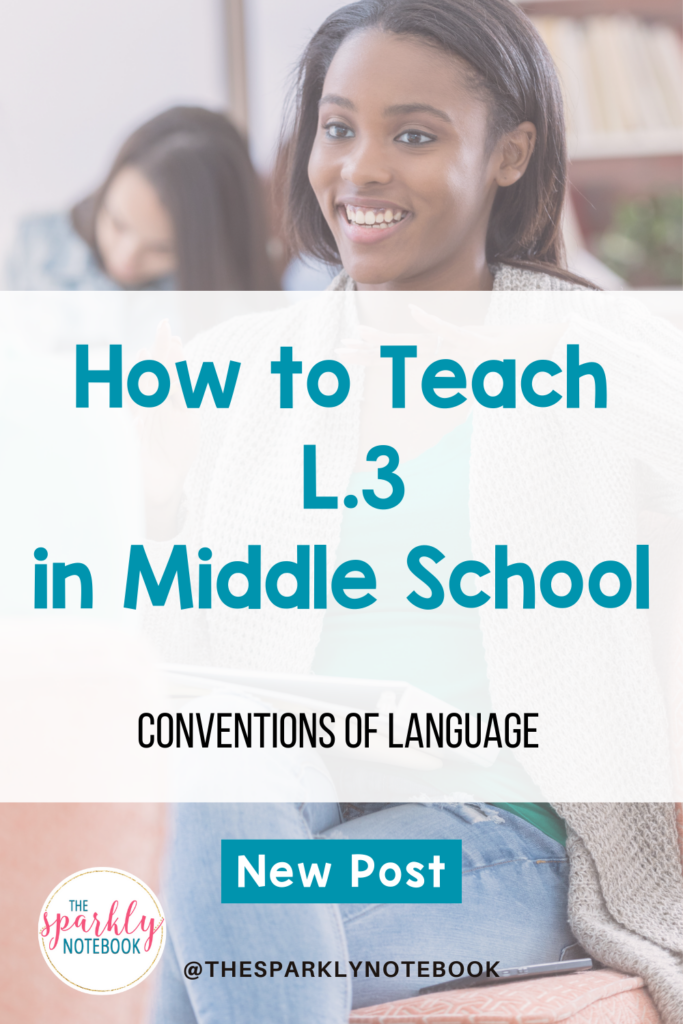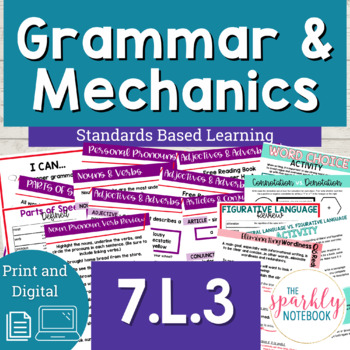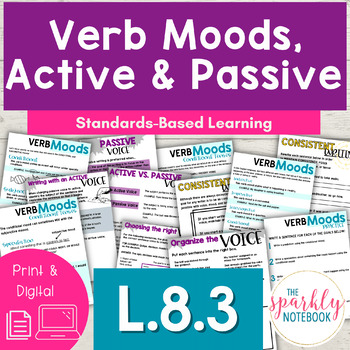A breakdown for teachers who teach L.3 in middle school ELA. In this post we’ve included learning targets, concept breakdown, resource suggestions, and activity and assessment ideas!
After teaching for a long time, I believe one of the greatest skills we can teach students is how to be concise in writing.
For some reason, we often feel that getting students to write more is the answer to getting them to write well, when it may be the exact opposite.
Through our word limits and page counts, we’ve raised students to believe that quantity is more important than quality; however, the L.3 standard reminds us, that is not true.
As we cover how to teach L.3 in middle school, we are focusing on word choice, efficiency, and tone in writing.
Let’s dig into the standards.

Learning Targets
By focusing on learning targets, we can model our lessons to hit very specific goals and skills. In this post, we talk about how we break down each standard and make a plan for learning, practicing, and reviewing the standards throughout the year using the checklists below.
We use the checklists to determine when we’ll work on each standard, including introduction, practice, review, and assessment. We also use the checklists to identify the learning targets for each standard and to figure out how the skills grow on each other from grade-level to grade-level.
Below, we’ve outlined the standards and learning targets for the 7th and 8th grade L.3 standards.
Teaching L.7.3 (7th Grade)

7th Grade Standard: Use knowledge of language and its conventions when writing, speaking, reading, or listening.
7th Grade Learning Targets
- I can use proper grammar and mechanics.
- I can choose precise words effectively.
- I can recognize and eliminate wordiness.
Teaching L.8.3 (8th Grade)

8th Grade Standard: Use knowledge of language and its conventions when writing, speaking, reading, or listening.
8th Grade Learning Targets
- I can use verbs in the active and passive voice to achieve particular effects.
- I can use verbs in the conditional and subjunctive mood to achieve particular effects.
- I can make my writing consistent and make sure the sentences are in uniform.
Growing through Middle School
As both of these standards are the same as written, we have to dig into grade-level expectations generally to decide what we’ll focus on at each level.
Through a lot of research, talking with other ELA teachers, researching past tests, and generally laying out the different skills this standard encompasses, we have decided to focus primarily on word choice and efficiency at 7th grade and types of voice (passive vs. active) as well as consistency in voice for the 8th-grade class.
These skills build on each other, but the ability to be concise and clear when it matters is probably the most important.
Being clear is often overlooked in writing and speaking. We often feel that ‘the more words, the better.’ That is not true. In fact, being concise is the easiest way to be heard and understood.
Rather than giving students word limits that result in long, lengthy, and wordy writing, encourage them to be efficient and focused instead.
Resources for teaching L.3
When picking resources to help teach L.3, you’ll want to make sure the resource teaches, practices, and reviews the standard at the appropriate level for the students you’re teaching. After you’ve thoroughly taught and practiced the skills, you can continue to add in themed practice throughout the year.
Click the links below to learn more about our L.3 units.
These resources include a lesson/activity for each specific learning target or concept as well as assessments, posters, and answer keys.
Activities and Projects for Practicing and Assessing L.3 in Middle School
- Reducing Word Count: Ask students to write an essay. Then, after they’ve written the best essay, ask them to reduce the word count by 30%. Then, after they have a new draft, ask them to reduce it by 30% again. This activity will help them see where they’re using extra, unnecessary words (or not choosing the right words) to make their point.
- Organizing the Voice: Give students several sample sentences. Some are written in passive voice, and some are in active voice. Ask students to sort the sentences. This is an activity in our 8th-grade resource.
- Study Verb Moods: Different verbs inspire different feelings and goals. Spend some time reviewing and playing around with verb moods. In our 8th-grade resource, we have a few handouts and activities to guide verb mood practice.
- Start with Parts of Speech: Although this standard is more about word choice and voice, the more students understand parts of speech, the more they can see what is necessary and what is extra. In our 7th-grade resource, we go over parts of speech in depth through a variety of handouts and activities.
- Connotative vs. Denotative Meaning: In our 7th-grade unit, we also review connotative vs. denotative meaning and review how a word’s meaning may be altered by the readers connotation.
You have a lot of options for teaching the L.3 standard, but our resources are designed to make sure students are being introduced to the standard fully. These 7th and 8th-grade resources are best used as an introduction to and review of the standard.
After working through the resources, you can then supplement throughout the year with a variety of other themed and holiday-inspired practices to keep the standard and skills fresh.
 7 Idea-Generating Activities for Setting Goals with Middle School Students
7 Idea-Generating Activities for Setting Goals with Middle School Students How to teach RL.1 in Middle School
How to teach RL.1 in Middle School  How to Prioritize One-on-One Conferences with Middle School Students
How to Prioritize One-on-One Conferences with Middle School Students